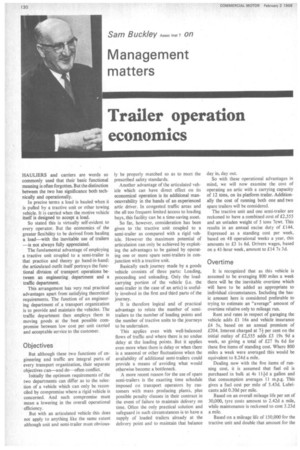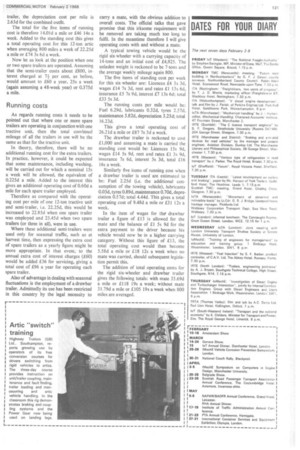Trailer operation
Page 132

Page 133

If you've noticed an error in this article please click here to report it so we can fix it.
economics
HAULIERS and carriers are words so commonly used that their basic functional meaning is often forgotten. But the distinction between the two has significance both technically and operationally.
In precise terms a load is hauled when it is pulled by a tractive unit or other towing vehicle. It is carried when the motive vehicle itself is designed to accept a load.
So stated this is virtually self-evident to every operator. But the economics of the greater flexibility to be derived from hauling a load—with the inevitable use of trailers —is not always fully appreciated.
The fundamental advantage of employing a tractive unit coupled to a semi-trailer is that practice and theory go hand-in-hand: the articulated outfit itself portrays the functional division of transport operations between an engineering department and a traffic department.
This arrangement has very real practical advantages apart from satisfying theoretical requirements. The function of an engineering department of a transport organization is to provide and maintain the vehicles. The traffic department then employs them in moving goods at the best possible compromise between low cost per unit carried and acceptable service to the customer.
Objectives
But although these two functions of engineering and traffic are integral parts of every transport organization, their separate objectives can—and do—often conflict.
Initially the optimum requirements of the two departments can differ as to the selection of a vehicle which can only be reconciled by compromise where a rigid vehicle is concerned. And such compromise must mean a lowering in the overall operational efficiency.
But with an articulated vehicle this does not apply to anything like the same extent although unit and semi-trailer must obvious
ly be properly matched so as to meet the prescribed safety standards.
Another advantage of the articulated vehicle which can have direct effect on its economical operation is its additional manoeuvrability in the hands of an experienced artic driver. In congested traffic areas and the all too frequent limited access to loading bays, this facility can be a time-saving asset.
So far, however, consideration has been given to the tractive unit coupled to a semi-trailer as compared with a rigid vehicle. However the maximum potential of articulation can only be achieved by exploiting the advantages to be gained by operating one or more spare semi-trailers in conjunction with a tractive unit.
Basically each journey made by a goods vehicle consists of three parts: Loading, proceeding and unloading. Only the loadcarrying portion of the vehicle (i.e. the semi-trailer in the case of an artic) is usefully involved in the first and third parts of the journey.
It is therefore logical and of practical advantage to relate the number of semitrailers to the number of loading points and the number of tractive units to the journeys to be undertaken.
This applies even with well-balanced flows of traffic and where there is no undue delay at the loading points. But it applies even more when there is delay or when there is a seasonal or other fluctuations when the availability of additional semi-trailers could provide a means of avoiding what would otherwise become a bottleneck.
A more recent reason for the use of spare semi-trailers is the exacting time schedule imposed on transport operators by customers with mass producing plants, plus possible penalty clauses in their contract in the event of failure to maintain delivery on time. Often the only practical solution and safeguard in such circumstances is to have a supply of loaded trailers already at the delivery point and to maintain that balance day in, day out.
So with these operational advantages in mind, we will now examine the cost of operating an artic with a carrying capacity of 12 tons, on its platform trailer. Additionally the cost of running both one and two spare trailers will be considered.
The tractive unit and one semi-trailer are reckoned to have a combined cost of £2,555 and an unladen weight of 5 tons lewt. This results in an annual excise duty of £144. Expressed as a standing cost per week, based on 48 operational weeks a year, this amounts to £3 Is 6d. Drivers wages, based on a 41-hour week, amount to £14 7s 3d.
Overtime
It is recognized that as this vehicle is assumed to be averaging 800 miles a week there will be the inevitable overtime which will have to be added as appropriate to individual circumstances. Including the basic amount here is considered preferable to trying to estimate an "average" amount of overtime relative only to mileage run.
Rent and rates in respect of garaging the vehicle adds £1 16s and vehicle insurance £4 5s, based on an annual premium of £204. Interest charged at 74 per cent on the initial outlay of £2,555 adds £3 19s 9d a week, so giving a total of £27 9s 6d for these five items of standing cost. Where 800 miles a week were averaged this would be equivalent to 8.24d a mile.
Dealing now with the five items of running cost, it is assumed that fuel oil is purchased in bulk at 4s 114d a gallon and that consumption averages 11 m.p.g. This gives a fuel cost per mile of 5.43d. Lubricants add 0.30d per mile.
Based on an overall mileage life per set of 30,000, tyre costs amount to 2.42d a mile, while maintenance is reckoned to cost 3.23d a mile.
Based on a mileage life of 150,000 for the tractive unit and double that amount for the trailer, the depreciation cost per mile is 2.63d for the combined outfit.
The total for the five items of running cost is therefore 14.01d a mile or £46 14s a week. Added to the standing cost this gives a total operating cost for this 12-ton artic when averaging 800 miles a week of 22.25d a mile or £74 3s 6d a week.
Now let us look at the position when one or two spare trailers are operated. Assuming that the semi-trailer costs about £800, interest charged at 71 per cent, as before, would amount to £60 a year, 25s a week (again assuming a 48-week year) or 0.375d a mile.
Running costs
As regards running costs it needs to be pointed out that where one or more spare trailers are operating in conjunction with one tractive unit, then the total combined mileage of all the trailers in use will be the same as that for the tractive unit.
In theory, therefore, there will be no additional running cost for the extra trailers. In practice, however, it could be expected that some maintenance, including washing, will be carried out for which a nominal 15s a week will be allowed, the equivalent of 0.225d a mile. Added to the interest this gives an additional operating cost of 0.60d a mile for each spare trailer employed.
Therefore as compared with the operating cost per mile of one 12-ton tractive unit and semi-trailer, i.e. 22.25d, this would be increased to 22.85d when one spare trailer was employed and 23.45d when two spare trailers (or three in all), were in use.
Where these additional semi-trailers were used only for seasonal traffic, such as at harvest time, then expressing the extra cost of spare trailers as a yearly figure might be more appropriate. In that event, to the annual extra cost of interest charges (£60) would be added £36 for servicing, giving a total cost of £96 a year for operating each spare trailer.
Also of advantage in dealing with seasonal fluctuations is the employment of a drawbar trailer. Admittedly its use has been restricted in this country by the legal necessity to carry a mate, with the obvious addition to overall costs. The official talks that gave promise that this irksome requirement will be removed are taking much too long to fulfil. In the meantime therefore I will give operating costs with and without a mate.
A typical towing vehicle would be the rigid six-wheeler with a carrying capacity of 14-tons and an initial cost of £4,925. The unladen weight is reckoned to be 7-tons and the average weekly mileage again 800.
The five items of standing cost per week for this six-wheeler are: Licences £4 3s 3d, wages £14 7s 3d, rent and rates £1 13s 6d, insurance £5 7s 9d, interest E.7 13s 6d; total E33 5s 3d.
The running costs per mile would be: Fuel 6.29d, lubricants 0.32d, tyres 2.57d, maintenance 3.82d, depreciation 3.23d; total 16.23d.
This gives a total operating cost of 26.21d a mile or £87 7s 3d a week.
The drawbar trailer is reckoned to cost £1,000 and assuming a mate is carried the standing cost would be: Licences 15s 9d, wages £14 5s 9d, rent and rates £1 3s 9d, insurance 7s 6d, interest 3s 3d, total £16 16s a week.
Similarly five items of running cost when a drawbar trailer is used are estimated to be: Fuel 2.25d (i.e. the additional consumption of the towing vehicle), lubricants 0.03d, tyres 0.89d, maintenance 0.70d, depreciation 0.57d; total 4.44d. This gives a total operating cost of 9.48d a mile or £31 12s a week.
In the item of wages for thei drawbar trailer a figure of £13 is allowed for the mate and the balance of El 5s 9d for the extra payment to the driver because his vehicle would now be in a higher carrying category. Without this figure of £13, the total operating cost would then become 5.58d a mile or £18 12s a week when no mate was carried, should subsequent legislation permit this.
The addition of total operating costs for the rigid six-wheeler and drawbar trailer gives the following totals: with mate 35.69d a mile or £118 19s a week; without mate 31.79d a mile or £.105 19s a week when 800 miles are averaged.




































































































































































































